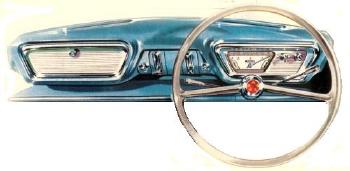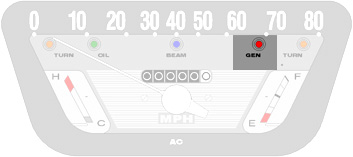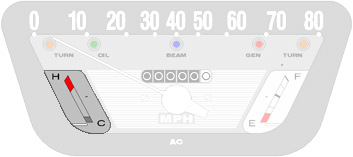You are in:

Speedometer
Head
Assembly |

Ford
Anglia 105E - Technical - Speedometer Head Assembly
| Ford
designed the Dashboard of the Anglia to be
symmetrical about the centre of the vehicle. The
glove box door and instrument binnacle could be
easily swapped from one side of the vehicle to
the other to produce right and left hand drive
vehicles. The instrument binnacle held a
Speedometer Head Assembly that held all of the
warning lights and gauges that Ford thought the
new Ford Anglia Owner would ever need. |

 |
| When
the Ford Anglia was released in 1959, these
Speedometer Head Assemblies contained Turn, Oil,
Main Beam and Generator warning lights, a
Temperature Gauge (deluxe models only), a Fuel
Gauge and a 0 to 80 mph (or 0 to 120 km/h)
speedometer. These Speedometer Head Assemblies
were made and supplied by both AC Delco (left)
and Smiths Instruments (right) and appeared to be
fitted to cars at random (as stocks of the
assemblies were made available?). The only
difference between the two assemblies was the
colour and shape of the odometer numbers and the
central printed part signifying whether the
speedometer was labelled for MPH or Km/h. On the Ford Anglia Standard
model the left hand side of the assembly
contained a plate with a diagram showing the gear
positions.

|
On
the Ford Anglia deluxe model, the left hand plate
was replaced with a Temperature Gauge, and
depending on whether the car was left hand drive
or right hand drive, could be one of the four
assemblies shown below.
 |
| In
May of 1961 the speedometer was changed so that
it read from 0 to 90 mph (or 0 to 140 km/h). There are some theories as
to why Ford changed the speedometer rating at
that time. One suggestion is that Ford found
that, in some circumstances, the Anglia could
travel faster than the posted 80 mph. Another
suggestion is that with the impending release of
the Van and Estate and the planning of the 1200cc
Super, it would be better to have a standard
Speedometer Head Assembly over the entire Anglia
Family. What ever the motivation was for the
change, the speedometer was modified.
Ford also took the
opportunity to upgrade both the Temperature
Gauge, by including the word "Normal",
and the Fuel Gauge to include 1/4, 1/2 and 3/4
graduations.

|
When
Ford initially released the Thames / Anglia Van in 1961, they used the
Standard Saloon's Dash assembly. The 1964 Van operator's manual (page 9) shows a less
"fancy" version of the Speedometer Head
Assembly for the "Standard" Van model.
I can only assume this news dash assembly was
introcuced to keep costs of the base Van model
down. This version did away with the Main Beam
and Oil warning lights and had the Generator
warning light in the area where the temperature
gauge would normally be located. The indicating
needle was also modified and the Fuel Gauge was
printed in a single colour.
 |

The Warning Lights
and Gauges Explained
A
description of each of the warning lights and
gauges in the Speedometer Head Assembly (taken
from a Ford Anglia Handbook) is given below:
 |
Turn Indicator Warning Light
- (Orange)
When the indicator lever is pushed upwards, the
left hand indicator bulbs “flash”, also
the appropriate warning light on the instrument
panel. Conversely, movement of the switch lever
from the position downwards, operates the right
hand indicator bulbs and panel warning light. |

 |
Oil Pressure Warning Light
- (Green)
The light marked “OIL” should glow when
the ignition is switched “on” but
should go out when the engine is running in
excess of idling speed. This warning light may
flicker momentarily when the engine is started or
running at idling speeds, but should it remain on
at normal running speeds, first check the engine
oil level. If the oil level is correct then
consult your Authorised Dealer in order that the
reason for the “flicker” may be
investigated. |

 |
Main Beam Warning Light
- (Blue)
This is the centre light on the instrument panel
marked “BEAM” and is illuminated when
the headlights are switched on in the normal
(high) position. The light goes out when the
headlight beams are dipped. |

 |
Generator Warning Light -
(Red)
This is marked "GEN" and is illuminated
when the ignition is switched "on". The
light goes out when the engine speed rises above
a fast idle, indicating that the generator is
charging the battery. |

 |
The Fuel Gauge
Mounted in the lower half of the instrument
panel, this gauge is connected with the ignition
circuit. The gauge will register when the
ignition key is switched to the “on”
position.
“It must be noted that this
gauge has been designed to eliminate needle
fluctuation whilst the vehicle is in motion.
Consequently, the correct reading will not be
obtained until the ignition has been switched on
for approximately 30 seconds.” |

 |
Water Temperature Gauge
- (Deluxe models only)
Indicates the water temperature in the cylinder
head. This gauge is electronically operated and
the ignition must be switched on to obtain a
reading. The normal operating temperature of 185
F, (85 C) is reached when the needle is in a
position approximately midway between the
“C” and “H” marks. |

 |
Speedometer
This indicates the speed of the car. Inset is a
mileage recorder (or “odometer”) which
registers the total distance travelled by the car
and is therefore a useful guide as to when
lubrication and maintenance services should be
carried out. |
 |
(Article Copyright © MellY Designs - Please do not
Reproduce without Permission)




|
|

